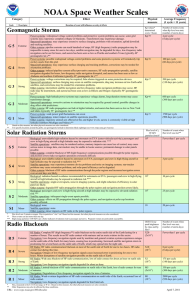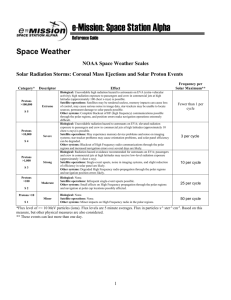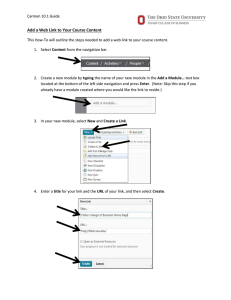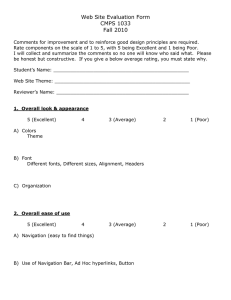Document 12587364
advertisement
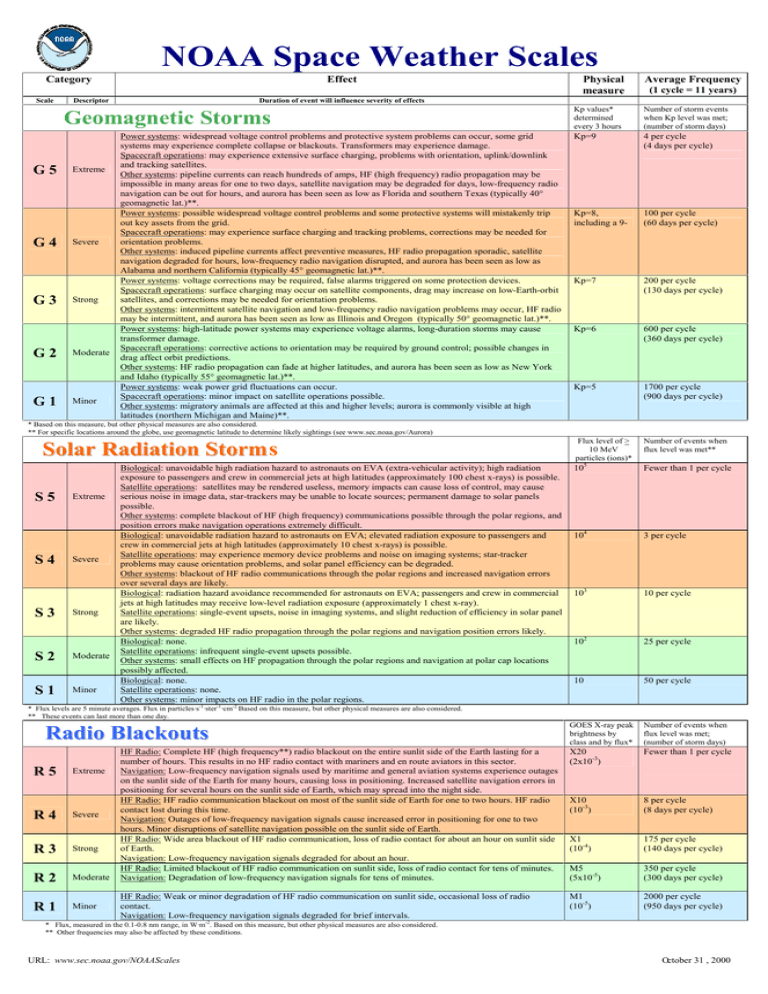
NOAA Space Weather Scales Category Scale Effect Descriptor G4 G3 G2 G1 Extreme Severe Strong Moderate Minor Average Frequency (1 cycle = 11 years) Duration of event will influence severity of effects Geomagnetic Storms G5 Physical measure Power systems: widespread voltage control problems and protective system problems can occur, some grid systems may experience complete collapse or blackouts. Transformers may experience damage. Spacecraft operations: may experience extensive surface charging, problems with orientation, uplink/downlink and tracking satellites. Other systems: pipeline currents can reach hundreds of amps, HF (high frequency) radio propagation may be impossible in many areas for one to two days, satellite navigation may be degraded for days, low-frequency radio navigation can be out for hours, and aurora has been seen as low as Florida and southern Texas (typically 40° geomagnetic lat.)**. Power systems: possible widespread voltage control problems and some protective systems will mistakenly trip out key assets from the grid. Spacecraft operations: may experience surface charging and tracking problems, corrections may be needed for orientation problems. Other systems: induced pipeline currents affect preventive measures, HF radio propagation sporadic, satellite navigation degraded for hours, low-frequency radio navigation disrupted, and aurora has been seen as low as Alabama and northern California (typically 45° geomagnetic lat.)**. Power systems: voltage corrections may be required, false alarms triggered on some protection devices. Spacecraft operations: surface charging may occur on satellite components, drag may increase on low-Earth-orbit satellites, and corrections may be needed for orientation problems. Other systems: intermittent satellite navigation and low-frequency radio navigation problems may occur, HF radio may be intermittent, and aurora has been seen as low as Illinois and Oregon (typically 50° geomagnetic lat.)**. Power systems: high-latitude power systems may experience voltage alarms, long-duration storms may cause transformer damage. Spacecraft operations: corrective actions to orientation may be required by ground control; possible changes in drag affect orbit predictions. Other systems: HF radio propagation can fade at higher latitudes, and aurora has been seen as low as New York and Idaho (typically 55° geomagnetic lat.)**. Power systems: weak power grid fluctuations can occur. Spacecraft operations: minor impact on satellite operations possible. Other systems: migratory animals are affected at this and higher levels; aurora is commonly visible at high latitudes (northern Michigan and Maine)**. Kp values* determined every 3 hours Number of storm events when Kp level was met; (number of storm days) Kp=9 4 per cycle (4 days per cycle) Kp=8, including a 9­ 100 per cycle (60 days per cycle) Kp=7 200 per cycle (130 days per cycle) Kp=6 600 per cycle (360 days per cycle) Kp=5 1700 per cycle (900 days per cycle) Flux level of > 10 MeV particles (ions)* Number of events when flux level was met** 105 Fewer than 1 per cycle 104 3 per cycle 103 10 per cycle 102 25 per cycle 10 50 per cycle * Based on this measure, but other physical measures are also considered. ** For specific locations around the globe, use geomagnetic latitude to determine likely sightings (see www.sec.noaa.gov/Aurora) Solar Radiation Storm s S5 S4 S3 Extreme Severe Strong S2 Moderate S1 Minor Biological: unavoidable high radiation hazard to astronauts on EVA (extra-vehicular activity); high radiation exposure to passengers and crew in commercial jets at high latitudes (approximately 100 chest x-rays) is possible. Satellite operations: satellites may be rendered useless, memory impacts can cause loss of control, may cause serious noise in image data, star-trackers may be unable to locate sources; permanent damage to solar panels possible. Other systems: complete blackout of HF (high frequency) communications possible through the polar regions, and position errors make navigation operations extremely difficult. Biological: unavoidable radiation hazard to astronauts on EVA; elevated radiation exposure to passengers and crew in commercial jets at high latitudes (approximately 10 chest x-rays) is possible. Satellite operations: may experience memory device problems and noise on imaging systems; star-tracker problems may cause orientation problems, and solar panel efficiency can be degraded. Other systems: blackout of HF radio communications through the polar regions and increased navigation errors over several days are likely. Biological: radiation hazard avoidance recommended for astronauts on EVA; passengers and crew in commercial jets at high latitudes may receive low-level radiation exposure (approximately 1 chest x-ray). Satellite operations: single-event upsets, noise in imaging systems, and slight reduction of efficiency in solar panel are likely. Other systems: degraded HF radio propagation through the polar regions and navigation position errors likely. Biological: none. Satellite operations: infrequent single-event upsets possible. Other systems: small effects on HF propagation through the polar regions and navigation at polar cap locations possibly affected. Biological: none. Satellite operations: none. Other systems: minor impacts on HF radio in the polar regions. * Flux levels are 5 minute averages. Flux in particles·s-1·ster-1·cm-2 Based on this measure, but other physical measures are also considered. ** These events can last more than one day. GOES X-ray peak brightness by class and by flux* Number of events when flux level was met; (number of storm days) HF Radio: Complete HF (high frequency**) radio blackout on the entire sunlit side of the Earth lasting for a number of hours. This results in no HF radio contact with mariners and en route aviators in this sector. Navigation: Low-frequency navigation signals used by maritime and general aviation systems experience outages on the sunlit side of the Earth for many hours, causing loss in positioning. Increased satellite navigation errors in positioning for several hours on the sunlit side of Earth, which may spread into the night side. HF Radio: HF radio communication blackout on most of the sunlit side of Earth for one to two hours. HF radio contact lost during this time. Navigation: Outages of low-frequency navigation signals cause increased error in positioning for one to two hours. Minor disruptions of satellite navigation possible on the sunlit side of Earth. HF Radio: Wide area blackout of HF radio communication, loss of radio contact for about an hour on sunlit side of Earth. Navigation: Low-frequency navigation signals degraded for about an hour. HF Radio: Limited blackout of HF radio communication on sunlit side, loss of radio contact for tens of minutes. Navigation: Degradation of low-frequency navigation signals for tens of minutes. X20 (2x10-3) Fewer than 1 per cycle X10 (10-3) 8 per cycle (8 days per cycle) X1 (10-4) 175 per cycle (140 days per cycle) M5 (5x10-5) 350 per cycle (300 days per cycle) HF Radio: Weak or minor degradation of HF radio communication on sunlit side, occasional loss of radio contact. Navigation: Low-frequency navigation signals degraded for brief intervals. M1 (10-5) 2000 per cycle (950 days per cycle) Radio Blackouts R5 Extreme R4 Severe R3 Strong R2 Moderate R1 Minor * Flux, measured in the 0.1-0.8 nm range, in W·m-2. Based on this measure, but other physical measures are also considered. ** Other frequencies may also be affected by these conditions. URL: www.sec.noaa.gov/NOAAScales October 31 , 2000

